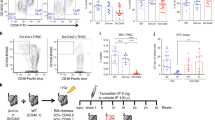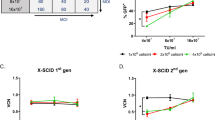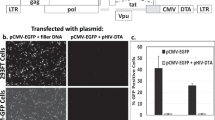Abstract
Severe 5-fluorouracil (5-FU) toxicity has been reported among patients lacking dihydropyrimidine dehydrogenase (DPD) enzymatic activity. DPD is the principal enzyme involved in the degradation of 5-FU to 5′-6′-dihydrofluorouracil, which is further metabolized to fluoro-β-alanine. We demonstrate here that overexpression of human DPD confers resistance to 5-FU in NIH3T3 cells, mouse bone marrow cells, and in human CD34+-enriched hematopoietic progenitor cells. An SFG-based dicistronic retroviral vector containing human DPD cDNA, an internal ribosomal entry site (IRES), and the neomycin phosphotransferase (Neo) gene was constructed (SFG–DPD–IRES–Neo). Transduced NIH3T3 cells demonstrated a 2-fold (ED50) increase in resistance to a 4-hour exposure of 5-FU in comparison to nontransduced cells. Expression of DPD was confirmed by Northern and Western blot analyses, and DPD enzyme activity was detectable only in transduced cells. Infection of mouse bone marrow cells with this retroviral construct resulted in an increased number of 5-FU–resistant CFU-GM colonies, compared to mock-transduced bone marrow in both 4-hour and 12- to 14-day exposures. Infection of human CD34+-enriched cells with this construct and incubation with 5-FU (10−6 M) for 14 days also resulted in an increased number of 5-FU–resistant colonies. Retroviral transduction of human hematopoietic progenitor cells with a cDNA-expressing human DPD conferred resistance to 5-FU in NIH3T3 cells, mouse bone marrow cells, and human CD34+-enriched cells. These results encourage the use of this gene as a method to protect patients from 5-FU myelotoxicity. Cancer Gene Therapy (2001) 8, 966–973
This is a preview of subscription content, access via your institution
Access options
Subscribe to this journal
Receive 12 print issues and online access
$259.00 per year
only $21.58 per issue
Buy this article
- Purchase on Springer Link
- Instant access to full article PDF
Prices may be subject to local taxes which are calculated during checkout
Similar content being viewed by others
References
Bierman PJ, Bagin RG, Jagannahath S, et al . High dose chemotherapy followed by autologous hematopoietic rescue in Hodgkin's disease: Long-term follow-up in 128 patients Ann Oncol 1993 14: 767
Rosti G, Albertazzi L, Salvioni R, et al . High-dose chemotherapy supported with autologous bone marrow transplantation (ABMT) in germ cell tumors: A phase two study Ann Oncol 1992 3: 809–812
Reece DE, Connors JM, Spinelli JJ, et al . Intensive therapy with cyclophosphamide, carmustine, etoposide±cisplatin, and autologous bone marrow transplantation for Hodgkin's disease in first relapse after combination chemotherapy Blood 1994 83: 1193–1199
Chopra R, McMillan AK, Linch DC, et al . The place of high-dose BEAM therapy and autologous bone marrow transplantation in poor-risk Hodgkin's disease. A single-center eight-year study of 155 patients Blood 1993 81: 1137–1145
Barnett MJ, Coppin CM, Murray N, et al . High-dose chemotherapy and autologous bone marrow transplantation for patients with poor prognosis nonseminomatous germ cell tumors Br J Cancer 1993 68: 594–598
May C, Gunther R, McIvor RS . Protection of mice from lethal doses of methotrexate by transplantation with transgenic marrow expressing drug-resistant dihydrofolate reductase activity Blood 1995 86: 439–2448
Li M-X, Banerjee D, Zhao SC, et al . Development of a retroviral construct containing a human mutated dihydrofolate reductase cDNA for hematopoietic stem cell transduction Blood 1994 83: 3403–3408
Chabner BA, Myers CE . Clinical pharmacology of cancer chemotherapy in cancer — principles and practice of oncology In: De Vita VT, Hellman S, Rosenberg SA, eds. Cancer Principles and Practice of Oncology, 3rd edn Philadelphia, PA: Lippincott 1989 349–395
Grem JL . 5-Fluoropyrimidines In: Chabner BA, Longo DL, eds. Cancer Chemotherapy and Biotherapy Principles and Practice, 2nd edn Philadelphia, PA: Lippincott 1996 149–211
Diasio RB, Harris BE . Clinical pharmacology of 5-fluorouracil Clin Pharmcokinet 1989 16: (4) 215–237
Daher GC, Harris BE, Diasio RB . Metabolism of pyrimidine analogues and their nucleosides Pharmacol Ther 1990 48: 189–222
Lu Z, Zhang R, Diasio RB . Purification and characterization of dihydropyrimidine dehydrogenase from human liver J Biol Chem 1992 24: 17102–17109
Lu Z, Zhang R, Diasio RB . Dihydropyrimidine dehydrogenase activity in human peripheral blood mononuclear cells and liver: Population characteristics, newly identified patients, and clinical implication in 5-fluorouracil chemotherapy Cancer Res 1993 15: 5433–5438
Ho DH, Townsend L, Luma MA, Bodely GP . Distribution and inhibition of dihydrouracil dehydrogenase activities in human tissues using 5-fluoruracil as a substrate Anticancer Res 1986 6: 781–784
Yokota H, Fernandez-Saiguero P, Furuya H, et al . cDNA cloning and chromosome mapping of human dihydropyrimidine dehydrogenase, an enzyme associated with 5-fluorouracil toxicity and congenital thymine uraciluria J Biol Chem 1994 269: 23192–23196
Diasio RB, Beavers TL, Carpenter TJ . Familial deficiency of dihydropyrimidine dehydrogenase J Clin Invest 1988 81: 47–51
Harris BE, Carpenter JT, Diasio RB . Severe 5-fluorouracil toxicity secondary to dihydropyrimidine dehydrogenase deficiency: A potentially more common pharmacogenetic syndrome Cancer 1991 68: 499–501
Lyss AP, Lienbaum RC, Harris BE, Diasio RB . Severe 5-fluorouracil toxicity in a patient with decreased dihydropyrimidine dehydrogenase activity Cancer Invest 1993 11: 239–240
Martin DS, Nayak P, Sawyer RC, et al . Enhancement of 5-fluorouracil chemotherapy with emphasis on the use of excess thymidine Cancer Bull 1978 30: 219–224
Wasternack C . Degradation of pyrimidines and pyrimidine analogs — pathways and mutual influences Pharmacol Ther 1980 18: 629–651
Daher GC, Naguib FN, El Kouni MH, Zhang RW, Soong SJ, Diasio RB . Inhibition of fluoropyrimidine catabolism by benzyloxybenzyluracil. Possible relevance to regional chemotherapy Biochem Pharmacol 1991 41: 1887–1893
Porter DJ, Chestnut WG, Taylor LC, Merrill BM, Spector T . Inactivation of dihydropyrimidine dehydrogenase by 5-iodouracil J Biol Chem 1991 266: 19988–19994
Molineux G, Migdalska A, Haley J, Evans GS, Dexter TM . Total marrow failure induced by pegylated stem cell factor administered before 5-fluorouracil Blood 1994 15: 3491–3499
Allay JA, Spencer HT, Wilkinson SL, Belt JA, Blakley RL, Sorrentino BP . Sensitization of hematopoietic stem and progenitor cells to trimetrexate using nucleoside transport inhibitors Blood 1997 90: 3546–3554
Markowitz D, Goff S, Bank A . A safe packaging line for gene transfer: Separating viral genes on two different plasmids J Virol 1988 62: 1120–1124
Markowitz D, Goff S, Bank A . Construction and use of a safe and efficient amphotropic packaging cell line Virology 1988 167: 400–406
Ercikan-Abali EA, Mineishi S, Tong Y, et al . Active site-directed double mutants of dihydrofolate reductase Cancer Res 1996 56: 4142–4145
Persons DA, Allay JA, Allay ER, et al . Retroviral-mediated transfer of the green fluorescent protein gene into murine hematopoietic cells facilitates scoring and selection of transduced progenitors in vitro and identification of genetically modified cells in vivo Blood 1997 90: 1777–1786
Rodgers GH, Hatfiels SM, Glasebrook AL . An improved colorimetric assay for cell proliferation and viability utilizing the tetrazolium salt XTT J lmmunol Methods 1991 142: 257–265
Ausubel FM, Brent R, Kingston RE . Current Protocols in Molecular Biology New York, NY: Wiley 1987
Laborda J . 36B4 cDNA used as an estradiol-independent mRNA control is the cDNA for human acidic ribosomal phosphoprotein PO Nucleic Acids Res 1991 19: 3998
Johnson MR, Yan J, Shao L, Albin N, Diassio RB . Semi-automated radioassay for determination of dihydropyrimidine dehydrogenase (DPD) activity. Screening cancer patients for DPD deficiency, a condition associated with 5-fluorouracil toxicity J Chromatogr, B: Biomed Sci Appl 1997 29: 183–191
Towbin H, Staehelin T, Gorden J . Electrophoretic transfer of proteins from polyacrylamide gels to nitrocellulose sheets: Procedure and some applications Proc Natl Acad Sci USA 1979 76: 4350–4354
Xu LC, Kluepfel-Stahl S, Blanco M, Schiffmann R, Dunbar C, Karlsson S . Growth factors and stromal support generate very efficient retroviral transduction of peripheral blood CD34+ cells from Gaucher patient Blood 1995 86: 141–146
Sobrero A, Aschele C, Bertino JR . Fluorouracil in colorectal cancer — a tale of two drugs: Implications for biochemical modulation J Clin Oncol 1997 15: 368–381
Blau CA, Neff T, Papayannopoulou T . The hematologic effects of folate analogs: Implications for using the dihydrofolate reductase gene for in vivo selection Hum Gene Ther 1996 7: 2069–2078
Acknowledgements
We thank Michel Sadelain for advice on retroviral vector construction and Sharon Bleau for CD34+ enriched cell separations. The statistical analyses were performed by Larry Leon, MS. Supported by USPHS Grants CA 59350, CA 62164, and CA 09512.
Author information
Authors and Affiliations
Corresponding author
Rights and permissions
About this article
Cite this article
Takebe, N., Zhao, SC., Ural, A. et al. Retroviral transduction of human dihydropyrimidine dehydrogenase cDNA confers resistance to 5-fluorouracil in murine hematopoietic progenitor cells and human CD34+-enriched peripheral blood progenitor cells. Cancer Gene Ther 8, 966–973 (2001). https://doi.org/10.1038/sj.cgt.7700393
Received:
Published:
Issue Date:
DOI: https://doi.org/10.1038/sj.cgt.7700393
Keywords
This article is cited by
-
γ-Glutamyl hydrolase modulation significantly influences global and gene-specific DNA methylation and gene expression in human colon and breast cancer cells
Genes & Nutrition (2015)
-
Protection of a cytidine deaminase gene gainst toxicity of high dose chemotherapy in mice
The Chinese-German Journal of Clinical Oncology (2008)
-
Reg IV is a serum biomarker for gastric cancer patients and predicts response to 5-fluorouracil-based chemotherapy
Oncogene (2007)
-
Protection of hematopoietic stem cells from pemetrexed toxicity by retroviral gene transfer with a mutant dihydrofolate reductase-mutant thymidylate synthase fusion gene
Cancer Gene Therapy (2004)
-
5-Fluorouracil: mechanisms of action and clinical strategies
Nature Reviews Cancer (2003)



